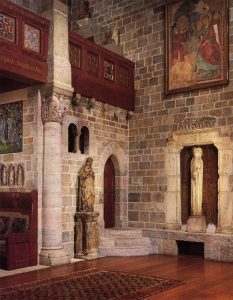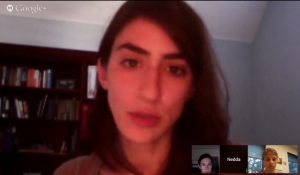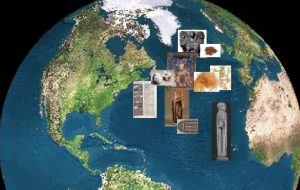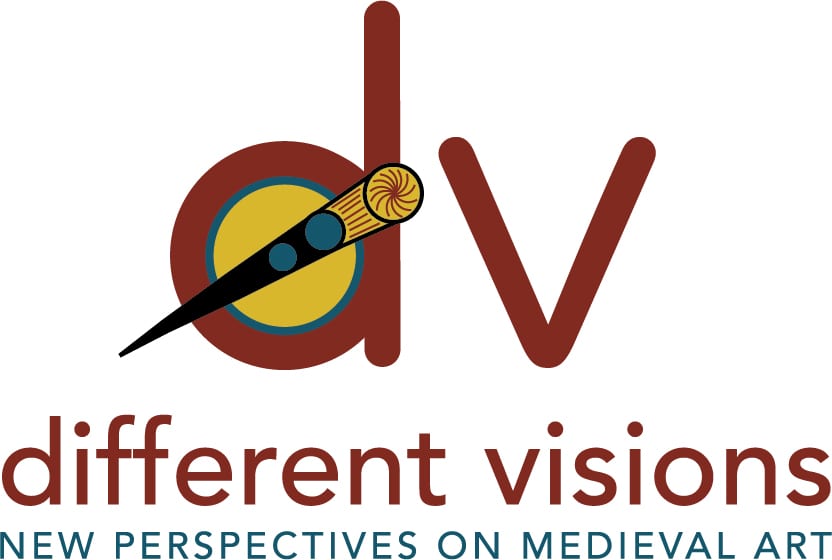But what do an Americanist and Anglo-Saxonist have to say to one another? This was precisely the question that first motivated the session. Save trotting together down the well-worn path that historicizes the nineteenth-century Anglo-Saxonism of Jefferson and other “Founding Fathers,” Melissa and Donna Beth’s disciplines rarely, if ever, permit shared dialogue. As a result, proposing a session required Melissa and Donna Beth not only to explore border crossings of BOTH time AND space, but also to think meta-critically about how to envision transtemporal and transspatial academic collaboration. We chose, as our session’s topic, the Atlantic Ocean, a body of water that brings together and stretches apart the Americas and Europe; and we asked for papers that considered material objects that crossed the Atlantic, hoping that their oceanic crossing would couple together issues of space with those of time.
Once upon a time (more precisely, a year later), the session was greenlighted by BABEL, and two Early Modernists (Mac Test and Nedda Mehdizadeh) along with a later-medievalist (Jennifer Borland) jumped aboard. Five different voices, representing four different periods, presented the redoubled challenge of talking to one another—meaningfully—on one conference panel.
Mac and Jennifer submitted papers about particular objects that cross the Atlantic. Mac’s paper considered the movement of bird feathers from Central America to Europe. Mac argues that as these feathers travel across the Atlantic they not only “indigeniz[e] European culture and art” but also adjoin the geographic spaces of Aztec and European empires, culturally and materially.
Jennifer Borland’s paper discussed a variety of medieval sculptures that were removed from their original fourteenth-century European contexts and reassembled in the twentieth-century Pennsylvania mansion of American collector, Raymond Pitcairn. In this case, medieval art “travels through time” as it crosses the Atlantic, enfolding past and present.

With Mac and Jennifer’s objects and arguments in front of us, Donna Beth, Nedda, and Melissa then met virtually to put them in dialogue, crafting a framework for the papers and, ultimately, for the project we were undertaking. Working with Mac and Jennifer’s papers required that we broker the spatio-temporal divides that separate each of us, professionally speaking, on the panel. It required that we work together, think together, share together in ways that rarely happen in a conference session. In fact, there’s a way in which the conference was “flipped” for us, to adopt a current pedagogy term. We crafted a session proposal, and then received our content. We then read and re-read each other’s work and “met” in the virtual space of the internet twice before all five of our bodies were ever in the same room.
Most of us did not know each other or each other’s work before beginning the conference session process, yet the in-person “performance” that resulted from our efforts was a reflection of conversations between five very different academic careers and projects in different stages—projects, investments, and questions that came together for an hour in a conference room on the Pacific.

This collectivist approach to our session resulted in an unconventional panel format, which we conceived of as a performance piece and a musical score. Mac and Jennifer presented two “acts” that were woven together by way of a series of movements–prelude, entr’acte, and postlude—written by Melissa, Nedda, and Donna Beth. Indeed, the writing process itself performed the transtemporal and transspatial movements we explored in our collective work. Like the fluidity of the Atlantic Ocean that brought, and continues to bring, various times and spaces together, our method of writing became an exercise in fluidity, in an openness to share ideas that would gain a new life precisely because they had moved in another’s port. Objects moved across time and space as our own disciplinary investments met, momentarily, in a shared time and space.
The result for each of us was an enlivening one. Though we had read and re-read, written and re-written our performance, like any performance it changed as it was enacted. We each saw new connections between objects, between ideas. Rather than bouncing off of each other in a traditional panel format, our ideas, questions, and arguments were already intertwined and received new life through the session itself.
What is the future of transtemporal and transspatial academic collaboration? We’re not entirely sure. But the kind of collective work that centered on the material objects of our panel might offer one way forward. In the discussion that followed our session one member of the audience noted that both Mac and Jennifer’s papers destabilized binaries of “us” versus “them” in certain ways, as historical players variously appropriated, but also “thought with” appropriated objects—delicate feathers and hefty stone sculptures. This seemed an apt way to describe the methodological work of the session more generally. We were momentarily asked to “think with” each other across traditional disciplinary boundaries. And no matter where that goes, it seems like a good thing.

The prelude, entr’acte, and postlude of our session appear below:
Prelude: “Trans”: Across, Over, Beyond
The Atlantic is an ocean that, like all geographies, carries the weight of human history. As an infamous “middle passage,” many of its travelers have not crossed this ocean freely or of their own accord; and, consequently, scholars have emphasized the Atlantic as a site of divisions, a site that has facilitated the development of slavery and empire, of modernity and capitalism. In recent decades, however, the Atlantic has come to be recognized not simply as a borderland that separates the “Old World” from the “New” but also as a space of connections: a body of water upon which ideas, materials, texts, and bodies travel.
While the Atlantic as a paradigm has variously divided and connected the “territories” of place, less attention has been paid to how it divides and connects the “territories” of time. In this panel, we consider this particular ocean as a geography across both space and time by examining some of the objects that travel upon it.
The two “papers” of this panel present two very different spatio-temporal engagements with the Atlantic and two very different objects that are ferried across its waters. Mac Test’s paper, which contemplates “space,” considers the movement of bird feathers from Central America to Europe. Mac argues that as these feathers travel across the Atlantic they not only “indigeniz[e] European culture and art” but also adjoin the geographic spaces of Aztec and European empires, culturally and materially. Jennifer Borland’s paper, which contemplates “time,” discusses a variety of medieval sculptures that are removed from their original 14th-century European contexts and reassembled in the 20th-century mansion of American collector, Raymond Pitcairn. In this case, medieval art “travels through time” as it crosses the Atlantic, enfolding past and present. By putting Mac and Jennifer’s papers in conversation, we extend, engage, and unsettle the “territorial boundaries” of very different spaces and very different time zones.
Moreover, by way of Mac and Jennifer’s arguments, this panel thinks about how the Atlantic—and the objects that traverse it—can broker the spatio-temporal divides that separate each of us, professionally speaking, on this panel. As a group, our scholarship ranges from 10th-century England to 19th-century America. We occupy divisions of space and time that are rarely traversed in a conference setting. How, then, can the Atlantic help us to reframe the geographic and temporal conversations that structure our fields? What might trans-temporal academic collaboration look like? Where might such collaboration be situated? As we gather on the edge of the Pacific, we look to the Atlantic to consider these questions.
We begin, first and foremost, with the panel’s format. As you can see from the program, this is a performance piece and a musical score. Mac and Jennifer present two “acts” that are woven together by way of a series of movements–prelude, entr’acte, and postlude–that frame and reframe (somewhat like a refrain) connections between time, space, and scholarship. Because we believe that this panel is as much about imagining a different mode of conferencing as it is about proposing a different vision of the ocean.
Act I
Scene 1: Medieval Art Objects
Scene 2: Aztec Feathers
Entr’acte: Ocean Travel/Time Travel
The carved stones and decorative feathers discussed in Jennifer’s and Mac’s “scenes” have ushered us into a multi-temporal, multi-spatial world, a world where each object is a marker of a given time and place even as it moves beyond the temporal and spatial boundaries from which it emerged.
As Jennifer presents us with a selection of architectural pieces from Pitcairn in order to discuss their provenance, these medieval artifacts melt into modern ones, and small towns in France begin to merge with large cities in America: the thirteenth-century polychrome sculpture of St. Paul might be a nineteenth-century fake; the cloister at Saint-Michel-de-Cuxa are buttressed against the Cloisters at the Met; and even the “haloed queen” from Demotte manages to wrangle together the 1785 demolition of Saint-Thibaut in Provins, Saint-Thibaut’s more likely demo date of 1822, and Pamela Blum’s scholarship about Saint-Thibaut from the 1990s. Mac’s feathers present us with similar spatial-temporal vectors: the ever-flying Birds of Paradise allow for seemingly impossible crossings between the Malukan Islands of Indonesia and Seville, Spain, a Moluccan “terrestrial paradise” and a biblical Eden; likewise the feather paintings that José de Acosta describes couple its Mexica artist, Pope Sixtus V of Italy, and King Philip II of Spain. Act I introduces us to objects of a particular time—later-medieval France—and objects of a particular space—Mesoamerica—in order to anticipate their transport across the time zones and space zones of the Atlantic. Already, however, stones and feathers have traveled. Already these objects have exceeded their places of origin.
The Atlantic Ocean doesn’t just permit these boundary crossings. As you can see, it gathers together, simultaneously, the memory traces of all of these objects that have passed across its waters. Likewise, it gathers us together, too. As we stand in the [powerpoint-ed] shadow cast by the Atlantic, we see that certain kinds of objects “matter” to us across space and time (and, by omission, certain kinds of objects fall short of memory).
We ask that you listen to Mac and Jennifer as they explore, independently, the trans-spatial and trans-temporal qualities of early modern feathers and medieval sculpture so that together, we might piece together another narrative, one that answers questions about why the Atlantic holds certain objects in its waters, and how this ocean cradles certain kinds of scholarship within its expanse.
Act II
Scene 1: Aztec Feathers in Europe
Scene 2: Medieval Art in America
Postlude: On Transatlantic and Transtemporal Collaboration
In Act II, scene 1 Mac explained how Mesoamerican feathers “indigenize” and hybridize the English utopias of Thomas More and Margaret Cavendish, transforming these trans-spatial fantasies into sites inhabited by “feathered-mantled priests” and “bird-human” astronomers. Moreover, when the actors in Ben Jonson’s masque, Volatees, costume themselves as bird-men, they find themselves at the physical cross-roads of “indigenization,” occupying the hybrid position of colonizer and colonized. Mac’s discussions of indigenization, hybridity, and colonialism find an unspoken echo in Jennifer’s scene. As Pitcairn builds a romanesque castle in which to house his stone sculptures, stained glass, and “architectural remnants,” this Pennsylvania magnate “indigenizes” art objects of medieval Europe in time with the architectural fashions of American medievalism. Collected, grouped, and displayed within the Great Hall, Glencairn becomes a “hybrid body” that bears witness to a different colonial partnership: an American billionaire purchases a past that is not his own and the Middle Ages becomes an American fantasy.
Though the “map” of the Atlantic we have been using thus far is a satellite projection, it bears striking resemblance to Mercator’s 1569 map of the world a map upon which our modern ones are still largely based. The centrality of the Atlantic Ocean, flanked by the Americas, Europe, and Africa orients it at the center of an imagined, global geography.
In many ways, the academic careers of each one of us falls in the shadow of the Mercator. Mac, Jennifer, Melissa, Nedda, and Donna Beth have been trained in a Euro-American tradition, a tradition that capitalizes upon the Atlantic Ocean’s colonial force: its ability to circuit together a trans-Atlantic “West” that cares about certain objects (and certain stories)—even as we decry them—because they perpetuate colonial narratives that are central to the trans-Atlantic histories of our professional fields.
Collaboration across space and time has helped us see this. Once Melissa, Nedda, and Donna Beth received and read Mac and Jennifer’s individual papers, we wrote and re-wrote and re-wrote the framing pieces of this panel around their work, a process that not only required protracted exchanges between the three of us but in the end had all five of us meeting “virtually” across four different time zones. Our planning for this session opened into spatio-temporal collusions, where we found ourselves querying each other’s disciplinary and field-specific interests and assumptions about the Atlantic. As a result, each of us had to look at our own period of specialization as peripheral to others, and each of us had to see our thoughts as not central, coherent arguments but merely “scenes” that could be spliced together.
Interestingly, as we each began to see our period and area of specialization as proximate to another, we began to peripheralize the Atlantic itself as we asked why it, rather than another oceanic space, became the geographic focus of our panel. We began to think about other bodies of water—like the Indian Ocean and the Caspian Sea—and the other histories those spaces hold. And we turned to other maps that would disrupt the Mercator’s vision of the world, maps in which the Atlantic was just a watery border to a Euroasiatic pangea, a sliver of ocean in comparison to the Aegean Sea, or an all-together unmapped space.
In some ways, our panel became as much about the process of its construction and about the process of collaboration across disciplinary times and spaces as about anything else, and we look forward to continuing our conversations, to extending this performance, with you now. How can we reorient our disciplinary spaces and times, and what challenges do we face as we do so?
